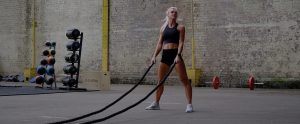Learn about Functional Training Workout Routines:
In today’s fast-paced world, with its myriad of demands and challenges, having a strong and capable body that can handle real-life situations is essential. Functional strength training offers a solution to this need by focusing on exercises that enhance overall physical functionality, enabling individuals to perform daily tasks with ease, prevent injuries, and excel in various activities. In this article, we will explore the concept of functional strength, its benefits, and how to incorporate it into your fitness routine to build a body that truly works in real life.

Understanding Functional Strength:
Functional strength is a form of training that goes beyond mere aesthetics or isolated muscle development. Instead, it targets the body as an integrated system, emphasizing movements and exercises that simulate real-life activities. The key principle is to improve the coordination and strength of multiple muscle groups simultaneously, fostering better performance in everyday tasks.
Unlike traditional weightlifting, where exercises focus on isolated muscle groups, functional strength exercises involve multi-joint movements that mimic the body’s natural patterns of motion. These movements engage in stabilizing muscles, tendons, and ligaments, enhancing overall stability and reducing the risk of injury.

The Benefits of Functional Strength Training:
1. Enhanced Daily Performance: Whether it’s carrying groceries, lifting a child, or moving furniture, functional strength training prepares your body for the physical challenges of everyday life. You’ll find yourself handling these tasks with greater ease and efficiency.
2. Reduced Risk of Injuries: By targeting stabilizing muscles and improving joint mobility, functional strength training helps prevent common injuries that may arise from repetitive movements or sudden strain.
3. Improved Athletic Performance: Athletes and fitness enthusiasts can benefit greatly from functional strength training. It enhances overall athleticism, agility, and power, translating to improved performance in sports and recreational activities.
4. Posture and Spinal Health: Functional exercises, especially those focusing on core engagement, promote better posture and spinal alignment. This can help alleviate chronic back pain caused by poor posture and sedentary lifestyles.
5. Efficient and Time-Saving Workouts: Functional strength workouts often involve compound exercises that engage multiple muscle groups simultaneously. This results in more efficient workouts, as you can target different areas of your body in less time.

Functional Strength Exercises:
1. Squats: An excellent functional exercise that strengthens the lower body and mimics movements like sitting down and standing up. Squats engage the quadriceps, hamstrings, glutes, and core.
2. Deadlifts: This exercise targets the posterior chain, including the hamstrings, glutes, and lower back. It improves lifting mechanics and enhances the body’s ability to lift objects off the ground safely.
3. Push-ups: A classic compound movement that targets the chest, shoulders, triceps, and core. Push-ups help replicate the motion of pushing objects in real-life scenarios.
4. Lunges: Lunges improve balance, stability, and strength in the legs, making them beneficial for activities like walking, running, and climbing stairs.
5. Farmer’s Walk: This exercise simulates carrying heavy objects over a distance, improving grip strength, core stability, and overall functional fitness.
Incorporating Functional Strength Training:
To incorporate functional strength training into your fitness routine, consider the following tips:
1. Seek Professional Guidance: Consult with a certified personal trainer or fitness expert to design a customized functional strength program that suits your goals and fitness level.
2. Start Gradually: If you are new to functional training, begin with bodyweight exercises to master proper form and gradually progress to using weights or resistance bands.
3. Focus on Form: Proper form is crucial in functional exercises to avoid injury and maximize effectiveness. Pay attention to your body’s alignment and engage the right muscles during each movement.
4. Include Variety: Mix different functional exercises to target various muscle groups and movement patterns. This will ensure balanced overall strength and flexibility.
•For More Information Click Here
•For More Facts Click Here



2 thoughts on “Functional Training Workout Routines”